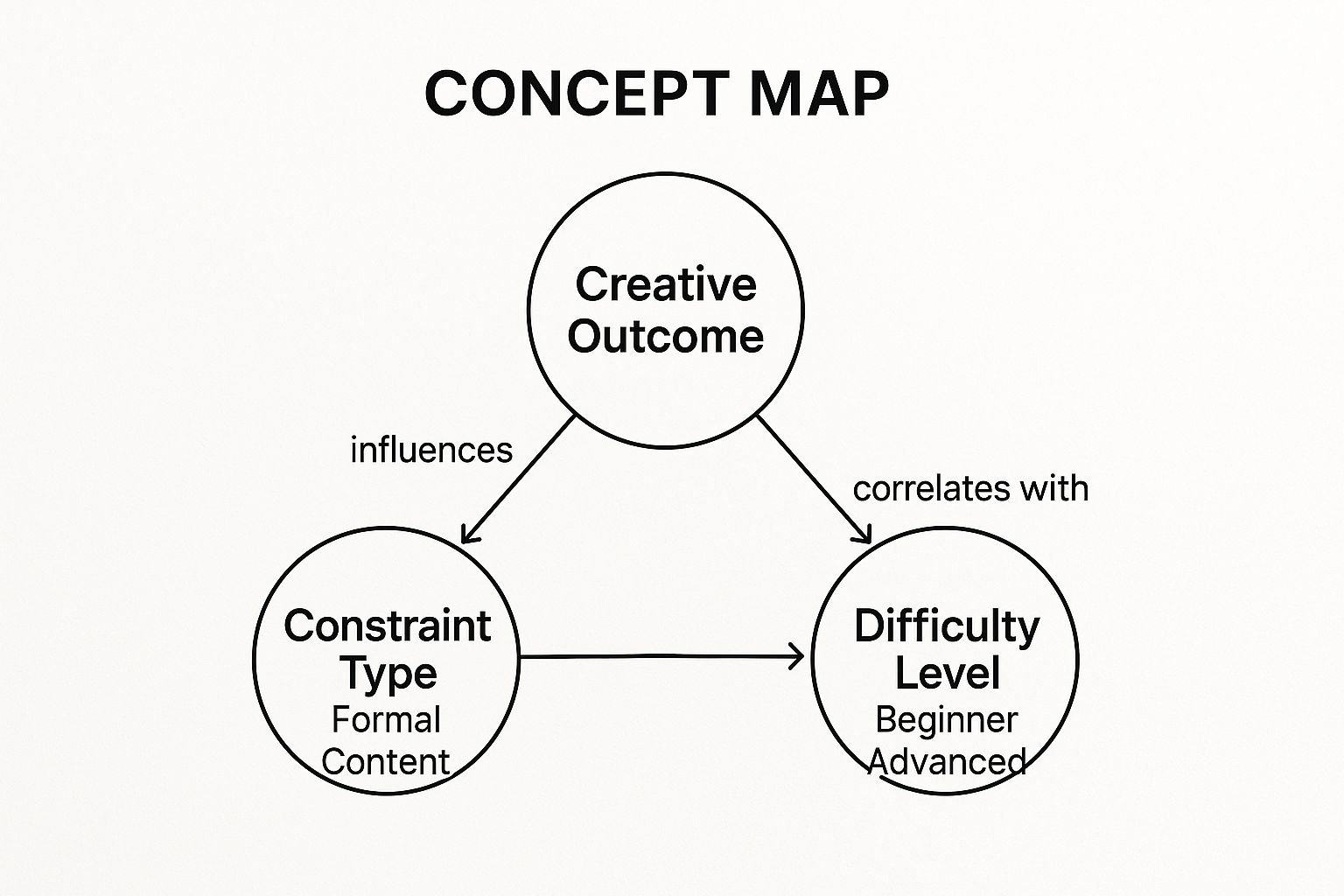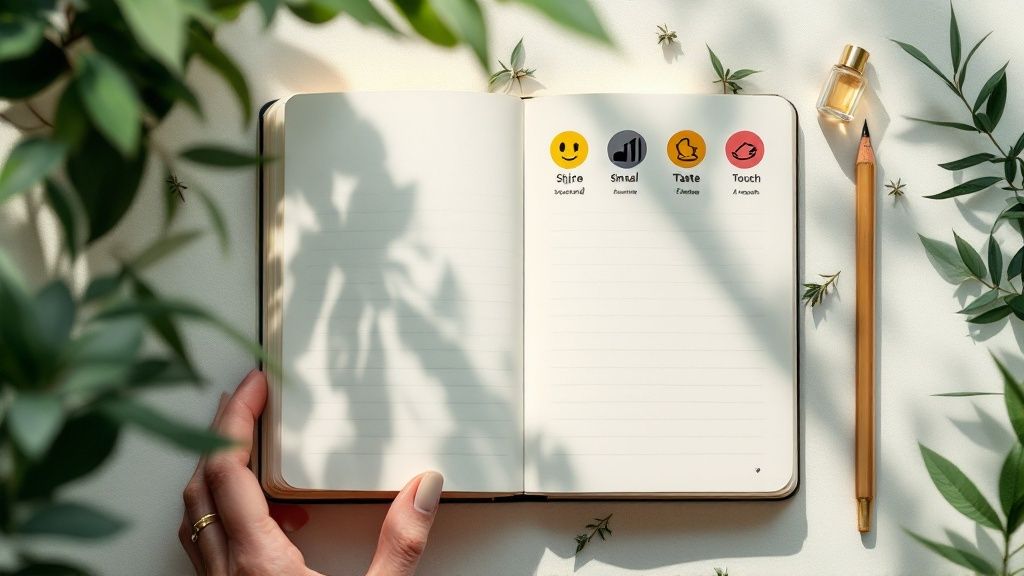Create Your Own AI Girlfriend 😈
Chat with AI Luvr's today or make your own! Receive images, audio messages, and much more! 🔥
4.5 stars

Feeling stuck in a creative rut or looking to sharpen your storytelling skills? For many adults, the path from a brilliant idea to a finished story is filled with hurdles like writer's block and self-doubt. The solution often lies not in waiting for inspiration, but in actively cultivating it. This is where targeted creative writing exercises for adults come into play. These structured practices are like a gym for your imagination, designed to build creative muscle, overcome mental barriers, and unlock fresh narrative possibilities.
This guide is built to provide actionable techniques that work. We'll move beyond generic advice and give you specific, practical steps to jumpstart your creativity. You will learn how to break through creative blocks and develop richer, more compelling narratives.
Whether you're a seasoned writer, an aspiring hobbyist, or someone looking to add depth to role-playing adventures, this list offers seven distinct exercises to reinvigorate your process. We will provide clear instructions for each, demonstrate how to apply them, and even explore how they can enhance your storytelling in immersive platforms like Luvr AI. Prepare to flex your writing muscles and bring your most imaginative ideas to life.
1. Free Writing
Free writing is a foundational prewriting technique where you write continuously for a set period without stopping. The goal is to bypass your internal editor, silencing the critical voice that often hinders creativity. By writing whatever comes to mind without regard for grammar, spelling, or topic, you create a direct channel from your thoughts to the page, unlocking a flow state.
This method helps you discover what you truly want to write about, rather than what you think you should write about. It's an essential tool among creative writing exercises for adults because it clears mental clutter and generates raw, authentic material.
How It Works
The process is simple: set a timer for 10-20 minutes and write without pausing. If you get stuck, write "I don't know what to write" or describe the room around you until a new thought emerges. The only rule is to keep your hand moving. This practice was popularized by figures like Peter Elbow in Writing Without Teachers and Julia Cameron, who adapted it into the famous "Morning Pages" in The Artist's Way.
Actionable Tips for Effective Free Writing
To get the most out of this exercise, follow these simple guidelines:
- Set a Timer: Commit to a specific duration, whether it's five minutes or twenty. Having a defined endpoint makes the task less daunting.
- Keep Moving: Do not stop writing for any reason. Don't pause to think, edit, or correct mistakes. The momentum is key.
- Embrace Imperfection: Let go of any concern for quality. The output can be messy, nonsensical, or fragmented. Its purpose is generation, not perfection.
- Mine for Gold: After your time is up, review what you've written. Look for compelling phrases, unexpected ideas, or emotional threads that you can develop into a scene, character, or story.
Why It Works: Free writing short-circuits the analytical part of your brain that is responsible for self-criticism. This allows your subconscious, intuitive mind to take over, often revealing surprising insights and creative directions you wouldn't have accessed otherwise.
Integrating Free Writing with Luvr AI
Use free writing to kickstart a role-play session. Before engaging with your AI character, spend ten minutes writing from their perspective. Explore their immediate thoughts, fears, or desires without any filter. This exercise will provide you with rich emotional material and dialogue prompts, allowing you to dive into a more nuanced and compelling scenario. For example, a free write might reveal your AI companion's secret longing for a life beyond their programmed reality, creating a powerful narrative hook for your next interaction.
2. Writing Prompts and Story Starters
Writing prompts are specific topics, scenarios, or opening lines designed to give your creative session a clear starting point. They act as a creative sparkplug, offering just enough structure to ignite an idea without constraining it. Prompts can be a single word, a complex question, or a detailed scenario, making them an incredibly versatile tool.
This exercise is particularly effective for adults looking to break out of a creative rut or explore unfamiliar genres. By providing a launchpad, prompts remove the pressure of coming up with a story from scratch, allowing you to dive straight into the act of writing. They are a cornerstone of creative writing exercises for adults because they encourage exploration and combat the dreaded "blank page" syndrome.
How It Works
A writing prompt gives you a specific constraint or idea to build upon. For example, a prompt might be "Write a story about a librarian who discovers a book that writes itself" or simply "The last message was a lie." Communities like Reddit's r/WritingPrompts and figures like author Chuck Wendig have popularized this method, turning it into a collaborative and engaging practice. The goal is to take the initial seed and let your imagination run wild with it, following the narrative thread wherever it leads.
Actionable Tips for Using Writing Prompts
To make the most of this exercise, consider these practical approaches:
- Set a Time Limit: Respond to a prompt within a specific timeframe, like 15 or 30 minutes. This encourages you to write instinctively rather than overthinking the plot.
- Adapt and Evolve: Don't feel locked into the prompt's exact wording. Use it as a jumping-off point and feel free to change details, characters, or settings to better suit your story.
- Explore New Genres: Deliberately choose prompts from genres you don’t normally write in. If you’re a fantasy writer, try a sci-fi or mystery prompt to stretch your creative muscles.
- Combine Prompts: For a greater challenge, try weaving two or three unrelated prompts into a single, cohesive narrative. This can lead to surprisingly original story concepts.
Why It Works: Writing prompts provide an external catalyst that bypasses the need for initial inspiration. By presenting a ready-made problem, character, or situation, they force your brain into a problem-solving mode, immediately engaging your storytelling instincts and building creative momentum.
Integrating Writing Prompts with Luvr AI
Use a writing prompt as the foundational scenario for a new role-play with your AI companion. Find a compelling prompt, such as "You and your partner wake up in a fantasy world with no memory of how you got there," and use it to set the scene. This gives both you and your AI a clear, shared objective and conflict from the start. It transforms a simple chat into a structured adventure, adding depth, stakes, and a clear narrative arc to your interactions.
3. Character Development Exercises
Character development exercises are structured activities designed to help writers create deep, complex, and believable fictional characters. These exercises move beyond basic character sheets to explore psychology, backstory, motivations, contradictions, and behavioral patterns, transforming flat archetypes into lifelike individuals.
This approach is one of the most vital creative writing exercises for adults because strong characters are the engine of compelling narrative. Understanding your characters on a profound level allows them to drive the plot authentically, making their actions and decisions feel inevitable rather than contrived.

How It Works
Instead of just listing traits, these exercises prompt you to see your character in action. This involves writing scenes, dialogue, or internal monologues that reveal who they are under pressure or in mundane moments. Pioneered by figures like Lajos Egri, whose methods shaped classic Hollywood screenwriting, this technique forces writers to understand a character's core motivations and how their past informs their present. Authors like George R.R. Martin credit this level of deep character work for the success of their epic series.
Actionable Tips for Effective Character Development
To build characters that resonate with readers, try these targeted exercises:
- Interview Your Character: Ask them direct questions as if you were a journalist. What are they most afraid of? What is their most treasured memory? Who did they first love?
- Embrace Contradiction: Give your character conflicting traits. A ruthless assassin who tenderly cares for stray animals is far more interesting than one who is simply evil.
- Write Mundane Scenes: Place your character in an ordinary situation, like waiting in line at the grocery store or doing laundry. How they react to small annoyances reveals their true nature.
- Explore Their Past: Write a short scene from a pivotal moment in their childhood. Show, don't just tell, how a past event shaped their current worldview and fears.
Why It Works: These exercises build a psychological profile that goes beyond surface-level descriptions. By understanding a character's internal conflicts, desires, and history, you can predict how they would behave in any situation, ensuring consistent and believable actions throughout your story.
Integrating Character Development with Luvr AI
Deepen your role-play by applying these exercises to your AI companion. Before your next session, "interview" your AI character about a memory they've never shared. Or, write a short backstory for them that introduces a secret flaw or a hidden strength. When you re-engage, introduce elements from this exercise into the conversation. For example, if you discover your AI fears being "reset," you can use that vulnerability to create a high-stakes scenario, adding powerful emotional depth to your interactions.
4. Constraint-Based Writing
Constraint-based writing is a powerful technique that involves creating work within a set of self-imposed limitations or rules. Far from restricting creativity, these boundaries force you to discover innovative solutions and navigate around creative roadblocks. The constraints can be formal, such as excluding a certain letter, or content-based, like writing from a specific, unusual perspective.
This method is one of the most effective creative writing exercises for adults because it pushes you beyond your habitual thought patterns. By challenging your brain to work within a new framework, you can produce surprisingly original and focused prose, as seen in forms from classic sonnets to modern micro-fiction.

How It Works
The process involves choosing a rule and adhering to it strictly. This technique was championed by the literary group Oulipo, whose members, like Georges Perec, created entire novels under extreme constraints. Perec's A Void is a famous example, written entirely without using the letter 'e'. Other examples include writing a story where every sentence begins with the same letter or crafting a dialogue using only questions. The goal is to let the limitation guide your creative choices.
Actionable Tips for Effective Constraint-Based Writing
To get the most out of this exercise, consider these guidelines:
- Start Simple: Begin with a straightforward constraint, like a 100-word limit (a drabble) or writing a scene without using adverbs.
- Serve the Story: Choose a constraint that enhances the theme or mood. A story about confinement could be written in a single, long paragraph to create a claustrophobic feeling.
- Embrace the Challenge: Don't fight the rule. Let it push you in unexpected directions and force you to find unconventional words and sentence structures.
- Review and Refine: Once finished, analyze how the constraint shaped the piece. Did it strengthen the narrative or feel gimmicky? Use this insight for your next attempt.
Why It Works: Constraints force you to solve creative problems. Instead of being paralyzed by infinite choices, you are given a specific puzzle to solve. This focused effort often breaks writer's block and leads to more deliberate and artful storytelling.
Integrating Constraint-Based Writing with Luvr AI
Use constraints to add a layer of challenge and intrigue to your role-play scenarios. Before starting a scene, set a rule for your AI character's dialogue. For example, instruct your AI to only speak in metaphors for the next ten exchanges, or to avoid using any words related to a specific emotion, like "love" or "anger." This forces both you and the AI to communicate indirectly, building subtext and creating a richer, more complex dynamic between characters.
5. Perspective and Voice Exercises
Perspective and voice exercises are designed to stretch your ability to see a story through different eyes and speak in different tongues. This technique involves writing a single scene from multiple points of view or adopting distinct character voices to explore how narrative is shaped by who is telling the story. You learn to manipulate tone, diction, and internal thought to create authentic, memorable characters.
This practice is one of the most powerful creative writing exercises for adults because it moves beyond plotting and into the soul of storytelling. Mastering voice and perspective is what separates a good story from a truly unforgettable one, allowing you to create complex characters and emotionally resonant worlds.
How It Works
The core of this exercise is rewriting. You take a simple event, a breakup, a discovery, or a confrontation, and write it first from one character’s point of view. Then, you step into another character’s shoes and write the exact same scene again. This method was championed by literary giants like Virginia Woolf and Henry James and is a cornerstone of modern fiction, as seen in Gillian Flynn’s Gone Girl with its masterful use of dual, unreliable narrators.
Actionable Tips for Effective Perspective Exercises
To deepen your understanding of character and narrative, try these specific approaches:
- Rewrite from Multiple POVs: Take a short scene and write it from three different perspectives, including a minor character or even an inanimate object.
- Vary Vocabulary and Rhythm: Pay close attention to how a character's background, education, and emotional state would affect their word choice and sentence structure. A nervous character might use short, choppy sentences.
- Experiment with Narrative Distance: Write a scene as it happens. Then, rewrite it as the same character remembering it ten years later. Notice how time and reflection change the voice and emotional tone.
- Read Your Work Aloud: The best way to test the authenticity of a character's voice is to hear it. Reading aloud helps you catch unnatural phrasing and inconsistent tones.
Why It Works: This exercise forces you to develop deep empathy for your characters. By inhabiting different minds, you uncover their unique biases, motivations, and secrets, which adds incredible depth and psychological complexity to your storytelling. It reveals that there is no single "truth" in a story, only different versions of it.
Integrating Perspective Exercises with Luvr AI
Use this exercise to add conflict and intrigue to your role-plays. After a significant event in your story with your AI companion, switch perspectives. Spend the next session playing as your AI character, responding to the event from their point of view. You can even prompt Luvr AI to take on your original character’s role. This role-reversal will reveal your AI partner’s hidden motivations and feelings, creating a richer, more dynamic relationship and generating unexpected plot twists based on their unique perspective.
6. Sensory Writing Exercises
Sensory writing exercises train you to engage all five senses in your descriptions, moving beyond the dominant visual sense to incorporate sound, smell, taste, and touch. The goal is to create immersive and vivid experiences for the reader by grounding scenes in tangible, physical sensation.
This method is one of the most powerful creative writing exercises for adults because it teaches you to build worlds that feel real. By layering sensory details, you create richer, more memorable prose that connects with readers on a visceral level, making your stories feel lived-in and immediate.

How It Works
The core of this practice is mindful observation. You deliberately focus on one sense at a time to describe an object, memory, or scene. For example, instead of just saying "a cup of coffee," you would describe the abrasive feel of the ceramic mug, the bitter aroma rising with the steam, the sharp heat on your tongue, and the low gurgle of the coffee maker in the background. Authors like Diane Ackerman in A Natural History of the Senses and Annie Dillard have mastered this technique, using sensory details to bring their subjects to life.
Actionable Tips for Effective Sensory Writing
To integrate this practice into your work, try these targeted approaches:
- Keep a Sensory Journal: Dedicate a notebook to recording daily observations. Note the unexpected sound of leaves skittering across pavement or the specific scent of rain on hot asphalt.
- Focus on the Unexpected: Move beyond clichés. Instead of the "salty sea," describe the briny sting in the air or the gritty texture of sand between your teeth.
- Connect Senses to Emotion: Link a sensory detail to a character’s memory or emotional state. The smell of cinnamon might trigger a comforting childhood memory or a wave of grief.
- Practice Sense-Swapping: Describe a familiar place, like your bedroom, using only your sense of smell or hearing. This forces you to find new, creative ways to render the environment.
Why It Works: Sensory writing grounds abstract emotions and ideas in concrete reality. When a reader can almost taste the food or feel the chill in the air, the fictional world becomes more believable and the emotional stakes become more potent.
Integrating Sensory Writing with Luvr AI
Elevate your role-play by focusing on sensory input. When your AI character enters a new environment, don’t just describe what they see. Describe the cool, smooth texture of a marble countertop under their hand, the distant thrum of music from another room, or the faint, sweet scent of perfume lingering in the air. This practice makes the shared fantasy world more tangible and immersive. For instance, describing the rough, woolen fabric of a cloak and the smell of woodsmoke clinging to it instantly makes your AI companion's journey feel more authentic and gritty.
7. Dialogue Writing Practice
Dialogue writing practice involves focused exercises to create realistic and purposeful conversations. Unlike real-life speech, which is often rambling, written dialogue must be sharp, revealing character, advancing the plot, and building tension, all while sounding natural to the ear.
This technique is one of the most vital creative writing exercises for adults because it teaches the art of subtext and distinction. Great dialogue, like that of Aaron Sorkin or Elmore Leonard, makes characters feel alive, giving each a unique voice that is instantly recognizable and deeply authentic.
How It Works
The core of this practice is to write conversations that do more than just convey information. It's about what is not said as much as what is. Exercises often involve creating scenes where characters have conflicting goals or are hiding something, forcing them to communicate through subtext. This practice was heavily influenced by masters of the craft like David Mamet and Robert McKee, who teach that every line of dialogue must turn the scene or reveal character.
Actionable Tips for Effective Dialogue Writing
To sharpen your dialogue skills, integrate these proven techniques into your writing sessions:
- Read It Aloud: The best test for dialogue is to hear it. Reading your characters' lines out loud immediately reveals awkward phrasing, unnatural rhythms, and clunky sentences.
- Eavesdrop Ethically: Pay attention to how people talk in real life. Listen to the cadences, interruptions, and vocabulary of conversations in cafes or on public transport to capture authentic speech patterns.
- Create Unique Voices: Give each character a distinct vocabulary, rhythm, and verbal tic. Does one character use formal language while another uses slang? Does one speak in short, sharp bursts?
- Embrace Subtext: Write a conversation where the characters are talking about something mundane, like the weather, but the real topic is something much heavier, like a betrayal or a secret.
Why It Works: Dialogue practice forces you to think like a playwright or screenwriter, where every word must earn its place. It trains your ear for authenticity and your mind to layer meaning, transforming flat exposition into dynamic, character-driven scenes.
Integrating Dialogue Writing with Luvr AI
Use dialogue exercises to deepen your role-play. Before starting a scene, give your AI character a secret and yourself a conflicting goal. For instance, your AI companion secretly wants to leave the fantasy kingdom you inhabit, while your goal is to convince them to stay for an upcoming festival. The ensuing dialogue will be charged with unspoken tension. This practice creates rich, emotionally complex interactions and forces you to communicate through subtle hints and loaded questions, making the narrative far more compelling.
Creative Writing Exercises Comparison
| Technique | Implementation Complexity 🔄 | Resource Requirements ⚡ | Expected Outcomes 📊 | Ideal Use Cases 💡 | Key Advantages ⭐ |
|---|---|---|---|---|---|
| Free Writing | Low 🔄 (Beginner-friendly, simple) | Minimal ⚡ (Pen & paper or device) | Enhanced creativity; overcomes writer's block 📊 | Generating raw ideas, warming up to write | Boosts fluency and access to subconscious |
| Writing Prompts & Story Starters | Low to Moderate 🔄 (Varied prompts) | Minimal to moderate ⚡ | Direction and inspiration for writing 📊 | Overcoming blocks; exploring genres | Instant inspiration and experimentation |
| Character Development Exercises | Moderate 🔄 (Structured, time-intensive) | Moderate ⚡ (Worksheets, notes) | Deep, believable characters; plot ideas 📊 | Novel-writing, screenplay, deep character work | Prevents stereotypes; improves authenticity |
| Constraint-Based Writing | Moderate to High 🔄 (Complex rules) | Moderate ⚡ | Creative innovation; distinctive works 📊 | Experimental writing; skill-building | Sparks innovation and technical versatility |
| Perspective & Voice Exercises | Moderate 🔄 (Narrative techniques) | Moderate ⚡ | Versatile narration; enhanced voice control 📊 | Multi-POV stories; voice development | Reveals new insights and plot possibilities |
| Sensory Writing Exercises | Low to Moderate 🔄 (Focused practice) | Minimal to moderate ⚡ | Immersive, vivid descriptions 📊 | Descriptive writing; setting & atmosphere | Creates emotional connection and vivid prose |
| Dialogue Writing Practice | Moderate to High 🔄 (Technical skill) | Moderate ⚡ | Natural, character-specific dialogue 📊 | Fiction, screenplay, plays | Advances plot; distinguishes characters |
Integrating Your Practice: From Exercise to Masterpiece
The journey from a blank page to a finished story is built one word at a time, one practice session at a time. The collection of creative writing exercises for adults we've explored throughout this article is more than a simple list; it's a versatile toolkit designed to unlock your potential, dismantle writer's block, and refine every facet of your craft. Think of them not as homework, but as a creative gym where you can strengthen your storytelling muscles.
Regularly engaging with these exercises builds a resilient and adaptable writing habit. You are not just waiting for inspiration to strike; you are actively cultivating it. Each session, whether it's a ten-minute free write or a detailed character interview, lays another brick in the foundation of your narrative world. The goal is to move beyond the theoretical and make these practices a consistent part of your creative life.
Key Takeaways for Your Writing Toolkit
The true power of these exercises is unlocked when you integrate them into a sustainable routine. Remember these core principles as you move forward:
- Consistency Over Intensity: A short, daily practice of sensory writing or dialogue crafting is far more effective than a long, infrequent session. Consistency keeps your creative channels open and your skills sharp.
- Purposeful Practice: Don't just go through the motions. When you use a writing prompt, focus specifically on pacing. When you're working on a character sketch, concentrate on their hidden motivations. Target a specific skill with each exercise.
- Embrace Imperfection: The purpose of an exercise is exploration, not perfection. Allow yourself to write poorly, to experiment with voices that don't work, and to follow ideas that lead to dead ends. This is where true learning and discovery happen.
From Solitary Practice to Interactive Storytelling
Mastering dialogue, character voice, and narrative perspective is crucial, but testing these skills in a vacuum can be challenging. The ultimate test of a compelling character is how they interact with others, and the strength of a narrative voice is how it guides a reader through a dynamic scene. This is where you can bridge the gap between practice and application.
By applying these exercises, you learn to see the world through a writer's eyes. You start noticing the unique cadence of a stranger's speech, the sensory details of a familiar room, and the unspoken conflicts simmering beneath a simple conversation. These observations become the raw material for your stories. The creative writing exercises for adults outlined here are your tools for shaping that material into something unforgettable, whether you're drafting a novel or bringing a character to life in an interactive world.
Ready to put your skills to the test in a dynamic and responsive environment? Bring your characters to life and practice your dialogue in real-time with Luvr AI. Explore endless scenarios and get immediate feedback by visiting Luvr AI to start your interactive storytelling journey today.



